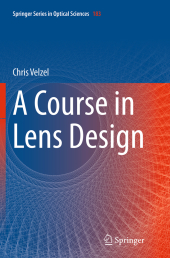 Neuerscheinungen 2016Stand: 2020-02-01 |
Schnellsuche
ISBN/Stichwort/Autor
|
Herderstraße 10
10625 Berlin
Tel.: 030 315 714 16
Fax 030 315 714 14
info@buchspektrum.de |

Chris Velzel
A Course in Lens Design
Softcover reprint of the original 1st ed. 2014. 2016. xv, 334 S. 231 SW-Abb., 90 Tabellen. 235 mm
Verlag/Jahr: SPRINGER, BERLIN; SPRINGER NETHERLANDS; SPRINGER 2016
ISBN: 9402407294 (9402407294)
Neue ISBN: 978-9402407297 (9789402407297)
Preis und Lieferzeit: Bitte klicken
This book teaches readers how to design sixteen types of lenses, from beginning to end. It introduces geometrical optics, optical instruments and aberrations as well as gives a description of the process of lens design and the strategies used in this process.
A Course in Lens Design is an instruction in the design of image-forming optical systems. It teaches how a satisfactory design can be obtained in a straightforward way. Theory is limited to a minimum, and used to support the practical design work. The book introduces geometrical optics, optical instruments and aberrations. It gives a description of the process of lens design and of the strategies used in this process. Half of its content is devoted to the design of sixteen types of lenses, described in detail from beginning to end. This book is different from most other books on lens design because it stresses the importance of the initial phases of the design process: (paraxial) lay-out and (thin-lens) pre-design. The argument for this change of accent is that in these phases much information can be obtained about the properties of the lens to be designed. This information can be used in later phases of the design. This makes A Course in Lens Design a useful self-study book and a suitable basis for an introductory course in lens design. The mathematics mainly used is college algebra, in a few sections calculus is applied. The book could be used by students of engineering and technical physics and by engineers and scientists.
Preface.
1 Geometrical Optics. 1.1 Principles of geometrical optics. 1.2 Paraxial optics. 1.3 Optical systems. 1.4 Paraxial raytracing. 1.5 Stops and pupils.
2 Optical instruments (paraxial approximation). 2.1 Camera. 2.2 Human eye. 2.3 Magnifier and microscope. 2.4 Telescopes. 2.5 Illumination.
3 Aberrations. 3.1 Wavefronts and aberrations. 3.2 Chromatic aberrations. 3.3 Calculation of aberration coefficients. 3.4 Stop shift equations. 3.5 Zero Seidel conditions.
4 Lens design process. 4.1 Specification. 4.2 Paraxial lay-out. 4.3 Thin lens predesign. 4.4 Surface model. 4.5 Optimization. 4.6 Tolerancing. 4.7 Diffraction theory for lens design.
5 Design strategies. 5.1 Colour correction. 5.2 Changing the number of variables. 5.3 Symmetries. 5.4 Stops and diaphragms. 5.5 Field correction.
6 Design examples. 6.1 Thin systems. 6.2 Design of a telescope. 6.3 Two-component systems. 6.4 Three component lenses. 6.5 Symmetric four-component lenses. 6.6 Microscope objectives. 6.7 Application of aspheric surfaces.
References. List of exercises. Index.


